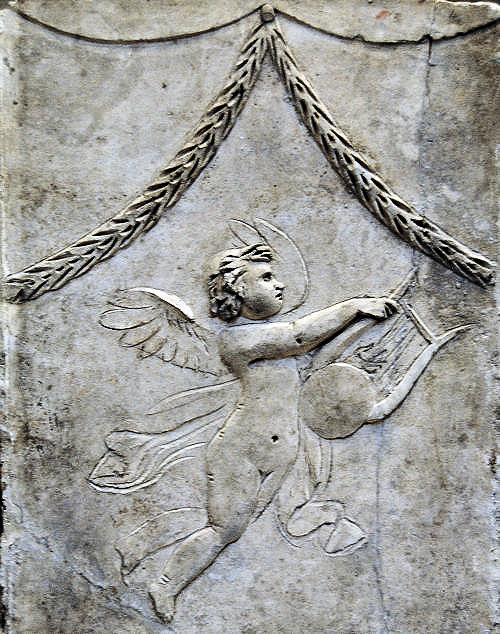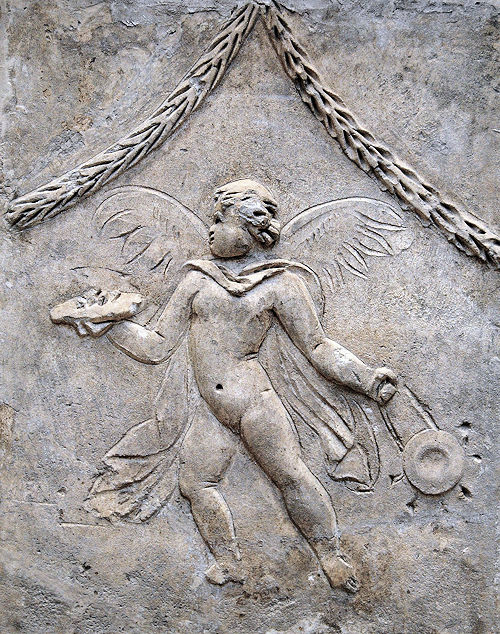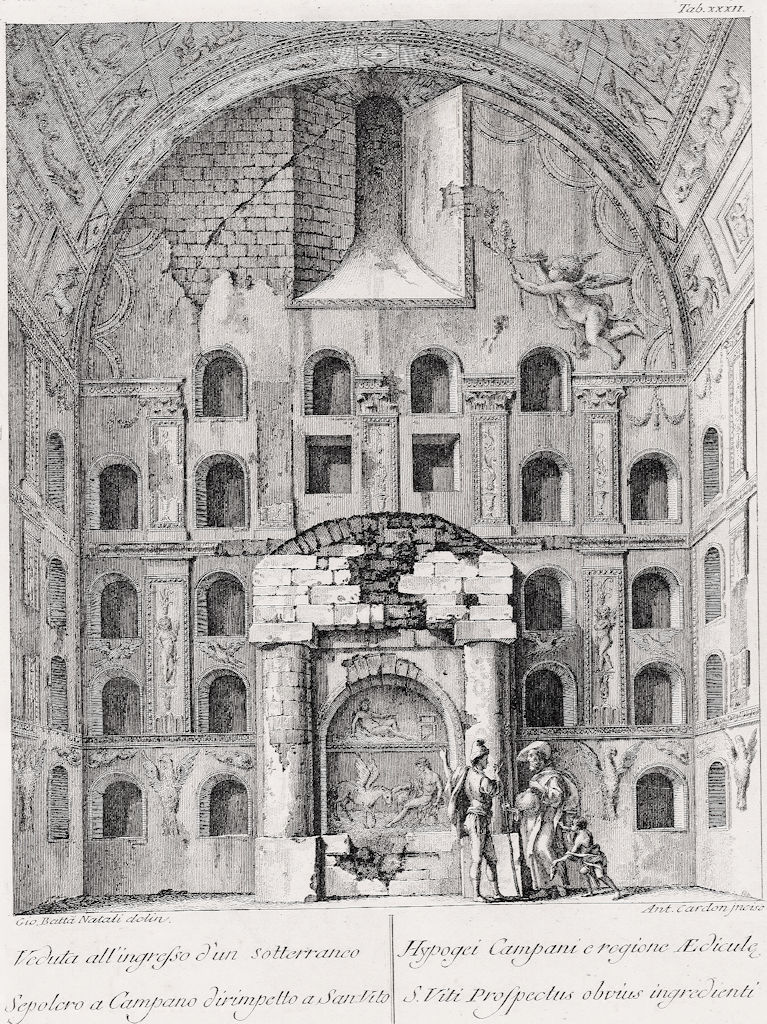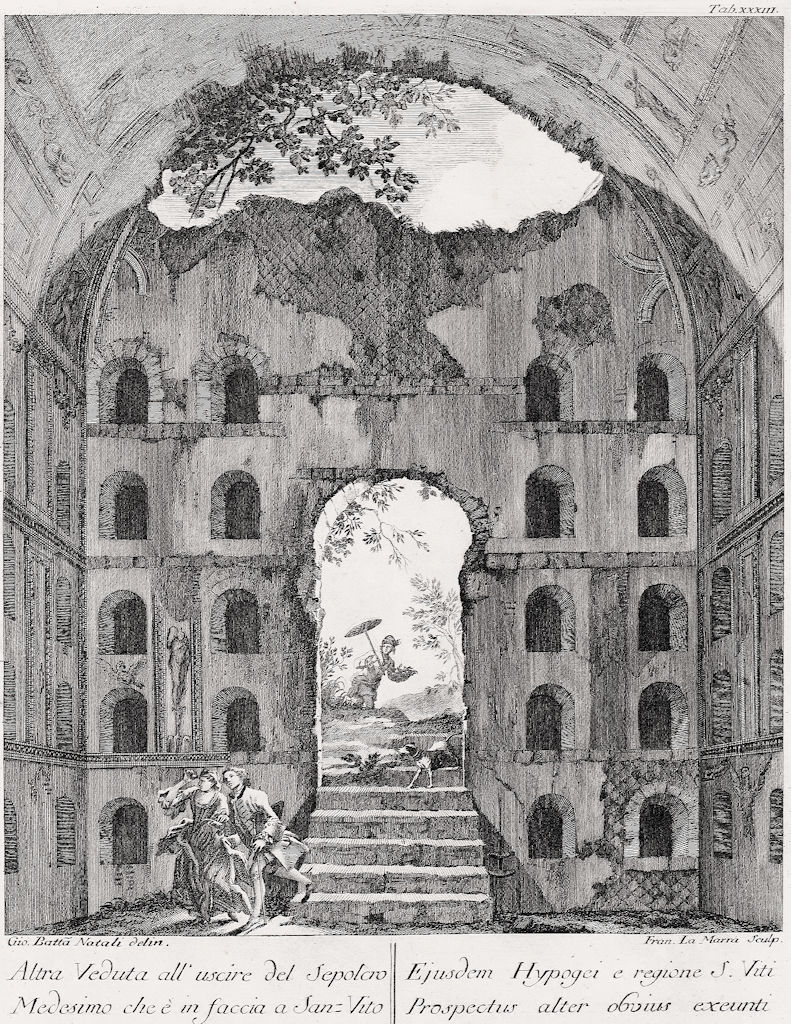Small sections of Puteoli's necropolis are known, but their fate in more recent times was not happy. In 1817 a tomb was investigated to the south-east of the city, measuring 4,50x 4,80 m. and with a marble doorway. It was described by Lorenzo Palladini, a soldier stationed in Pozzuoli. The discovery of four sarcophagi and a mosaic is reported.
One of the sarcophagi, taken to the Archaeological Museum in Naples, is quite famous: it depicts the myth of Prometheus, creating man from clay. Prometheus sits in front of his creation, still a dead body, lying on the ground. Psyche, the goddess of the soul, is brought in from the right by a winged and a wingless Eros. The winged Eros touches the head of the creature with a torch. To the left of this group, in front of Prometheus, stands the Fate Clotho, spinning the thread of life. Above the group appear Jupiter and Juno. Juno hands Mercury, with wings on his head and holding the caduceus, a pouch, for which Pluto is eagerly extending his right hand. Neptune stands in front of Pluto, holding a trident with his right hand and a dolphin with his left. Beneath Neptune lies Tethys, the personification of the sea, holding an oar. The entrance to the underworld is in the lower left corner. Hecate sits here and holds Cerberus on a chain. To her right sits a little boy, probably the personification of the sleep of death, Sopor. In the lower right corner is the earth goddess Terra Mater. In front of her Vulcanus forges metal on an anvil. In the upper right corner is Sol in a quadriga, in the upper left Luna. The sarcophagus has been dated to the third century.
The Prometheus sarcophagus. Arachne has a full description in German.
Archaeological Museum, Naples. Photo: Wikimedia, Jebulon.Another sarcophagus ended up in the Hermitage in Saint Petersburg, in 1926. A third emerged in Hearst Castle, San Simeon (California, USA), also in 1926. Erotes hold a clipeus with portraits of a deceased couple, below which is the inscription IVLIAE ET COCCEIVS. The scene is flanked by lions. The sarcophagus has been dated to the late third century. The fourth sarcophagus has disappeared.
The sarcophagus in Hearst Castle, USA.
Photo: Wikimedia, Davidlwinkler.The mosaic was deemed to be of low artistic quality and neglected. It was also taken to the museum in Naples and eventually believed to come from Herculaneum. Three figures related to water are depicted, two male, one female. Their identification is uncertain.
The mosaic with figures related to water.
Archaeological Museum, Naples. Photo: Wikimedia, MatthiasKabel.In 1870 the Victoria and Albert Museum bought 18 stucco reliefs that had been excavated in the mid-19th century in Pozzuoli. They were given on loan to the British Museum. At least 10 come from three tombs at locality Fondo Fraia. The tombs can no longer be identified and were perhaps demolished. The reliefs were taken from niches in the walls. The interpretation of some of the reliefs is still problematic. These have been called a parody, a representation of sorcery, or a scene from a play. The reliefs cannot be dated accurately.
Stucco relief from a tomb, Fondo Fraia. A parody of the legend of Perseus and Andromeda?
Photo: British Museum.
Stucco reliefs from a tomb, Fondo Fraia. Depictions of sorcery?
Images: Minervini 1862, Tav. VIII.


Stucco reliefs from a tomb, Fondo Fraia.
Photo: British Museum.Some other stucco reliefs in the British Museum were taken from a tomb at locality San Vito, discovered at the end of the 17th century. Today not much of the decoration is left. The interior of the chamber measures 4.75 x 5.75 m., the height is impressive: 5.85 m. to the crown of the vault. Urns were placed in many niches, not, however, as is usual, sunk into the bottom of the niches. The tomb and its decoration have been assigned to the Flavian-Trajanic period.


Interior of the San Vito tomb.
Drawings by Giovanni Battista Natali published by Paolo Antonio Paoli in 1768.